Sheldon Brown's
Bicycle Glossary W

|
![]()
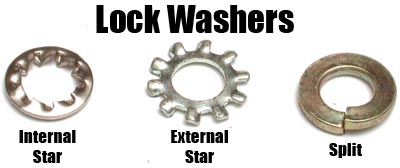 Lock washers have one or more directional teeth that act like pawls against the bearing surface of the fastener. These make it easier to turn the fastener in the tightening direction than in the loosening direction, so it is less likely that the nut or bolt will rattle loose.
Lock washers have one or more directional teeth that act like pawls against the bearing surface of the fastener. These make it easier to turn the fastener in the tightening direction than in the loosening direction, so it is less likely that the nut or bolt will rattle loose.Keyed washers are almost always used on threaded headsets, often also used on the bearings of pedals.
Formerly, keyed washers were used on hub axles, but that has gone out of favor.
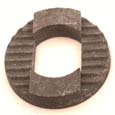 Anti-rotation washers have a non-round hole and fit on a matching non-round shaft. These washers are designed to keep parts from rotating.
Anti-rotation washers have a non-round hole and fit on a matching non-round shaft. These washers are designed to keep parts from rotating.
Internal gear hubs often have combination serrated/anti-rotation washers. These feature a tab or tabs that fit into the forkend's axle slot. They are used to keep the hub's axle from twisting in the frame. (Internal gear hubs have one or more gears mounted on the axle inside the hub, and this gear has to resist some force from pedaling in the higher or lower gears . The force is in opposite directions, depending on the gear selected, so if the axle in not properly secured, it will twist back and forth, causing the axle nuts to loosen up.
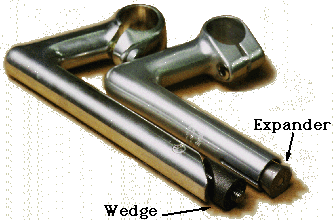
It is vitally important that the stem extender (or stem) not be inserted so far that the wedge is installed where the steerer is narrowing, or it could come loose unpredictably.
When this happens, only the edge/corner of the quill or wedge contacts the steerer, and it is trying to "grab" a slanted surface.
This is sometimes a problem on smaller frames if you try to insert the stem or a stem riser too far down into the steerer.
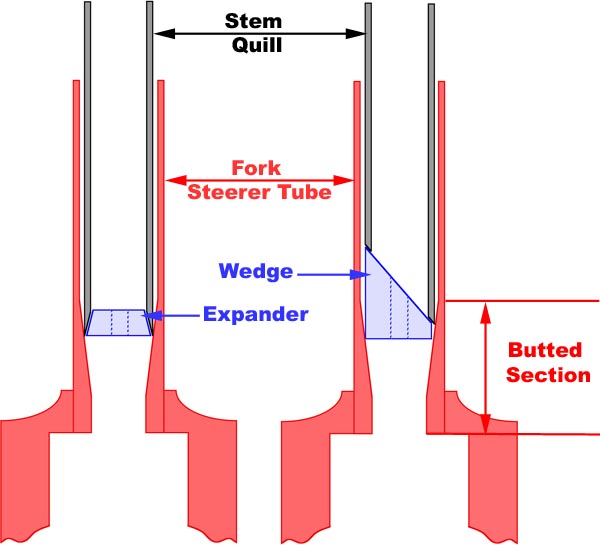
Illustration by Nicholas Flower
![]()
![]()
They combine the raised (or dropped, depending how you look at it) center that keeps rod brake shoes free from the risk of hitting the spokes, with the flat sides required for rim brakes.
One excellent feature of Westrick rims is their parallel sidewalls, which allow a caliper brake to work more evenly if a rim is out of true. However, the hollow, steel sidewalls are easily deformed by curb and pothole impacts, and the chromed steel braking surfaces are very slippery when wet.
Westwood rims are most commonly seen in the 635 mm (28 x 1 1/2) size, but they were made in most of the middleweight British sizes.
![]()
![]()
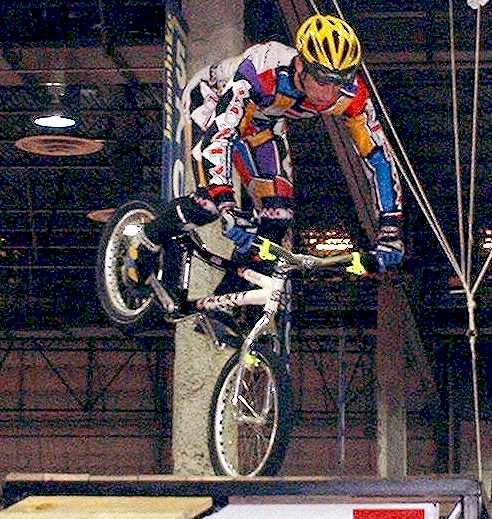 A "nose wheelie" results when the front brake is applied hard enough to cause the rear wheel to lift off. A controlled one is called a "stoppie" or "front wheelie." An uncontrolled one in which the cyclist goes over the handlebars is called an "endo" and may result in a "face plant."
A "nose wheelie" results when the front brake is applied hard enough to cause the rear wheel to lift off. A controlled one is called a "stoppie" or "front wheelie." An uncontrolled one in which the cyclist goes over the handlebars is called an "endo" and may result in a "face plant."
Early wheelie bikes were home-made by adapting a bike made for a small child for use by a larger child. A frame from a 20" wheel child's bike would be equipped with tall "ape hanger" handlebars and a "banana seat" which extended back over the rear wheel. The resulting weight distribution created a bicycle that would do a wheelie with the slightest effort.
The American bicycle industry, led by Schwinn with its "Stingray" and "Krate" models, jumped on this early '60's fad. Schwinn made a lot of short-term profit, but, I believe, the wheelie bike led to a serious long-term setback for the American bicycle industry.
Before the wheelie-bike craze, there was a well-established progression of frame sizes for growing children, from 16", to 20", to 24" and finally to 26" wheel bicycles. The wheelie bike killed the 24" bike market, because these bikes would sort-of fit children who should really have been riding on 24" wheels.
Wheelie bikes also greatly reinforced the idea that the bicycle was a child's toy, not a serious vehicle. Wheelie bikes were easy to do wheelies on, but their awkward riding position made them hellishly uncomfortable to actually ride more than a half-mile at a time.
Wheelie bikes in turn were killed by BMX bicycles, which are much more "rideable", but the 24" market never completely recovered.
![]()
![]()
He was also one of the first to establish a standardized set of screw threads and wrench sizes. Whitworth fasteners were used in British industry up until the late 1960's, when Britain adopted the metric system. The Whitworth system is now virtually extinct.
Whitworth fasteners used a 55 degree thread angle. The wrench sizes were confusingly marked, the wrenches are all larger than you would think. This is because the dimension given on a Whitworth wrench is the diameter of the bolt thread usual for that size wrench, rather than the size of the head. Some Whitworth wrenches even have two marked sizes, because the same head size is used with one coarse thread and a different-diameter fine thread.
Some of the smaller-sized Whitworth threads are interchangeable with S.A.E. threads.
Wooden rims went out of style for road bicycles when rim brakes came in, but continued to be use on the track well into the '40's. They were eventually outlawed for competition because of their dangerous failure mode: When a highly-tensioned racing wheel with a metal rim was damaged, it would fold up, but it would stay together. Similar wood-rim wheels, when overstressed, would suddenly turn into a cloud of sharp, dangerous splinters.
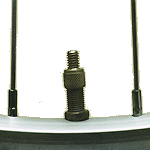 |
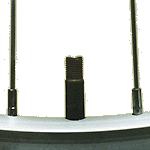 |
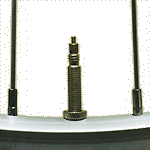 |
|---|---|---|
| Woods valve | Schrader valve | Presta valve |
Newer versions use a modern spring-loaded valve mechanism.
![]()
![]()
Wrenches are divided into two families:
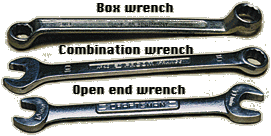 Box wrenches, which have a complete loop that surrounds the fastener. They are substantially stronger than open-end wrenches, and are the best to use for high torque applications, both because the wrench is stronger, and because it can contact more than two corners of the fastener.
Box wrenches, which have a complete loop that surrounds the fastener. They are substantially stronger than open-end wrenches, and are the best to use for high torque applications, both because the wrench is stronger, and because it can contact more than two corners of the fastener.Bicycle applications often call for special-purpose open-end wrenches:
I have an article about Cone Wrenches in my Tool Tips series.
Most socket wrenches are part of modular systems, and have interchangeable handles available, including ratchet handles, torque-wrench handles, extensions, breaker bars, and screwdriver-type handles; also extensions, to insert the socket deep into a mechanism, and universal joints, to use when the socket can not be at a right angle to the handle. Extensions and universal joints are not commonly needed for bicycle work.
6 Point vs 12 Point: Socket and box wrenches for hex fasteners come in two types, 6 point and 12 point.
12 point is good for box wrenches, because it gives you twice as many possible orientations to put the wrench on the fastener. This is especially good for working in close quarters, but is rarely an issue on bicycles. 6-point wrenches are stronger and less likely to slip. Generally, 6 points are preferable for bicycle work when you have a 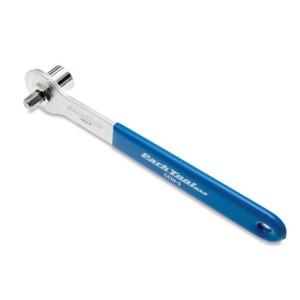 choice.
choice.
A crank bolt wrench is a special socket wrench used to tighten and loosen the bolts or nuts which attach square-tapered cranks to axles. A crank bolt wrench may also include an Allen wrench, as some crank bolts use one. Some older cranks use different sizes: see my article on cotterless cranks.
I have an article about Nutdrivers in my Tool Tips series.
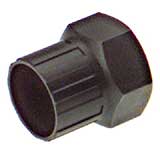 Spline Wrenches (including Torx, freewheel, etc.) have protruding splines on the inside or outside. Spline wrenches used on bicycles are mostly special wrenches which fit only one particular type or brand of bicycle parts. Many, including the one shown, need to use another wrench as a handle.
Spline Wrenches (including Torx, freewheel, etc.) have protruding splines on the inside or outside. Spline wrenches used on bicycles are mostly special wrenches which fit only one particular type or brand of bicycle parts. Many, including the one shown, need to use another wrench as a handle.I have an article about Adjustable Wrenches in my Tool Tips series.
![]()
![]()
![]()
Last Updated: by Harriet Fell